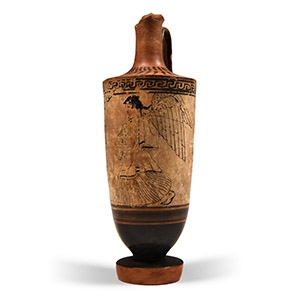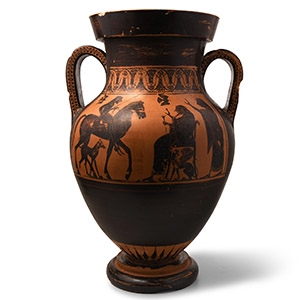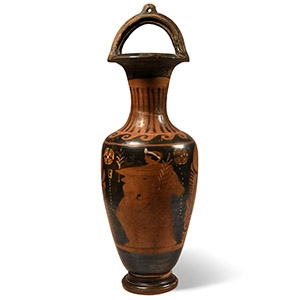Home > Auctions > 4 June - 8 June 2024
Ancient Art, Antiquities, Natural History & Coins
Auction Highlights:
Tackey Crist, Cyprus Museum collection, NC, USA.
Ex Leland Little auctions.
with Cyprus Museum of Jacksonville, North Carolina, USA.
Cf. Ancient Art from Cyprus, the Cesnola collection, p. 33.
Exhibited: The Cyprus Museum, Jacksonville, North Carolina, 1988-2018.
The piece is reminiscent of earlier white-painted wares of the middle-late Cypriot period. Although wheel-made white-painted ware is known from as far back as the Late Cypriot period (1300-1200 B.C.), the present piece must date to the Roman occupation of the island (from approximately the 2nd century B.C. onwards) because of the reserved (not impressed) Latin characters extant on the underside. The characters appear to have been applied to the clay whilst the vessel was wet. The inscription is impossible to decipher fully but contains the characters ... IN... ..AN.... ...DE M..... The use of 'D rather than Greek delta 'Δ' implies a Latin text.
In the collection of Mr Ulfert Wilke, founding Director of the University of Iowa Museum of Art.
Acquired from Ulfert Wilke on 29 May 1968.
From the collection of Dr Howard Sirak, Columbus, Ohio, USA.
Ex I.M. Chait Gallery, Los Angeles, USA, 14 December 2020, lot 212.
Property of a South Australian private collector, with collection reference 20.34.
Accompanied by detailed collector's catalogue pages including description and photograph.
De Puma, Etruscan and Villanovan Pottery: A Catalogue of Italian Ceramics from Midwestern Collections, no. 45.
The catalogue cites this piece as no. 3.10 from the Wilke Collection and the original sticker is on the base. The catalogue was for the exhibition at the University of Iowa Museum of Art from 17 March to 30 April 1971.
From a collection acquired on the UK art market from various auction houses and collections mostly before 2000.
From an important Cambridgeshire estate; thence by descent.
Accompanied by a thermoluminescence analysis report no.N124d55 from Oxford Authentication.
Cf. fragment of a similar vessel in the British Museum under accession no.1888,0601.762.
From the George R. Francoeur Trust, Bloomfield Hills, Michigan, with collection inventory no.319; acquired in 1982.
Ex Hindman Auctions, Chicago, USA, sale, lot 72.
Property of a South Australian private collector, with collection reference 20.09.
Accompanied by detailed collector's catalogue pages including description and photograph.
Accompanied by a Francoeur Trust inventory card with inventory number 82.319), along with collection label 319 to its base.
George R. Francoeur (1934-2019) received his Master’s Degree of Fine Arts from the University of Michigan and was a dedicated arts teacher for many years at Cranbrook Academy of Arts. His collection of ancient art was offered at auction by Hindman Auctions, with the proceeds benefiting the George R. Francoeur Scholarship Fund at Cranbrook Academy of Art.
Cf. De Puma, R., Corpus Vasorum Antiquorum, The Paul Getty Museum – Malibu, Etruscan Impasto and Bucchero, Malibu, 1996, pl.319, for similar example with higher neck.
Impasto and bucchero also share techniques that were used to form and decorate the vessels. Bucchero chalices with distinctive fluted walls were popular products during the first half of the 6th century B.C. at a number of Etruscan sites. It is likely that the inspiration for fluted chalices came from metalwork. Undecorated examples have been found at Poggio Buco.
Ex Richard Brockway, Vero Beach, Florida, USA.
Ex Arte Primitivo, New York, USA, in 1995.
with Artemis Gallery, Colorado, USA, 22 February 2019, lot 48E (US$2,500-3,500).
Property of a South Australian private collector, with collection reference 20.07.
Accompanied by detailed collector's catalogue pages including description and photograph.
Ex Galerie am Museum Jürgen Haering, Freiburg, Germany.
From the collection of Dr Werner Cordes, Hagen, Germany, 1988.
with Hammer Auktionen, Basel, Switzerland, sale 54, lot 121.
Property of a South Australian private collector, with collection reference 21.25.
Accompanied by detailed collector's catalogue pages including description and photograph.
From a collection acquired on the UK art market from various auction houses and collections mostly before 2000.
From an important Cambridgeshire estate; thence by descent.
Cf. Boucher, S., Recherches sur les Bronzes Figurés de Gaule Pré-Romaine et Romaine, Rome, 1976, item 22, for a more naturalistic treatment of a similar subject; also an item in the British Museum under accession no.1824,0437.1; Thomson de Grummond, N., & Simon, E., The Religion of the Etruscans, Austin, 2006, fig.p.94, for similar although of later age.
The gesture is typical for making sacrifice. The curved hem of the garment, which originally could be seen both behind and in front of the left leg, shows that this is a tebenna, a typical Etruscan male dress, distinguished by its semi-circular shape from the rectangular Greek himation.
Ex Elsa Blohsh-Diener collection, Bern, Switzerland.
Property of a French collector.
Cf. more elaborate version of a similar figure in the British Museum under accession no.1825,1112.1.; cf. Reinach, S., Répertoire de la statuaire Grecque et Romaine, Paris, 1897, p.481, nos.8-9.
From the collection of Lord Elgin (BAPD 12703).
Ex Coins and Medals, Attic Red-Figure Vases, Basel, Special List N, May 1971, no.48.
Ex Imhof collection, Germany.
Acquired Bonhams & Brooks, London, 26 April 2001, no.37.
From the C.K. private collection, Graz.
with Gorny & Mosch, Munich, 30 June 2017, no.15.
Property of a North London collector.
Accompanied by copies of the relevant Bonhams & Brooks and Gorny & Mosch catalogue pages, and the original Bonhams & Brooks lot tag.
Once in the collection of Lord Elgin. With the corresponding pages of the M&M and Bonhams catalogues (copies).
Ex German private collection.
with Hampel Kunst Auction, Munich, 2012, no.867.
Private European collection, thence by family descent.
Accompanied by an academic report by Dr Raffaele D’Amato.
This lot has been checked against the Interpol Database of stolen works of art and is accompanied by a search certificate number no.12069-218134.
Cf. Boardman, J., Early Greek Vase Painting, London, 1998, p.219ff., ill.483-484, p.245 for a comparison; see neck amphora with Heracles killing the Nemean Lion, in the Harvard University, inventory no.1960.312, in Robinson, D. M., ‘Unpublished Greek Vases in the Robinson Collection,’ in American Journal of Archaeology (1956), 60.1, 1-25, p.7-9, no. 8, pl.5; cf. a similar terracotta neck-amphora (jar) attributed to the Polyphemos Group in the Metropolitan Museum, accession no.46.11.5.
The shape is typical of the period, and is decorated with black-figured technique, in which the figures were silhouetted in black slip on a reddish clay ground, and linear elements were incised with a needle, with additional details painted with white and cherry red-slip. The amphora seems to belong to one of the sub-types of the ‘Pseudo-Chalcidian’ group (the Poliphemus group), derived from the main Chalcidian series
with Artemis Gallery, Munich, Germany, before 1998.
with Oliver Forge, London, UK.
Private collection, acquired from the above.
Accompanied by a copy of an Art Loss Register certificate.
Accompanied by an academic report by Prof. Neritan Ceka.
This lot has been checked against the Interpol Database of stolen works of art and is accompanied by a search certificate number no.12092-218139.
The life-size head represents an adult male, probably still in his youth. The man is depicted with a short hair, and probably wearing a diadem of which the lower edge is partially visible. The size, the use of marble, and the quality of this work suggest that it was a portrait of a nobleman or possibly a prince of the Hellenistic period.
From a British deceased estate.
with Christie's, London, 28 April 2009, no.239.
Property of a North London collector.
Accompanied by copies of the relevant Christie's catalogue pages.
49 - 60 of 2809 LOTS

.jpg)

.jpg)
.jpg)
.jpg)
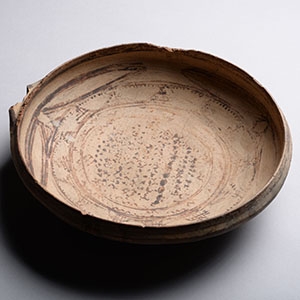
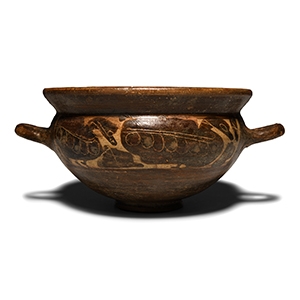


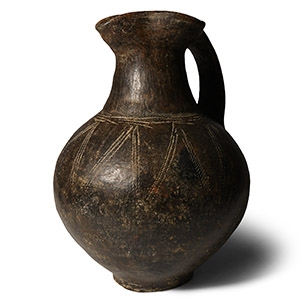
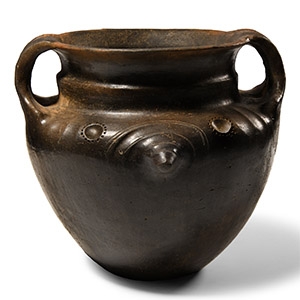
.jpg)
.jpg)
